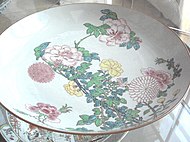 Porzellansammlung Porzellansammlung | |
| Interactive fullscreen map | |
| Location | Dresden, Germany |
|---|---|
| Coordinates | 51°3′7.9″N 13°44′4.6″E / 51.052194°N 13.734611°E / 51.052194; 13.734611 |


The Dresden Porcelain Collection (German: Porzellansammlung) is part of the Staatliche Kunstsammlungen (State Art Collections) of Dresden, Germany. It is located in the Zwinger Palace.
History
The collection was founded in 1715 by the Saxon Prince-Elector Augustus the Strong, and was originally housed in the Japanese Palace (then known as the "Dutch Palace") on the banks of the Elbe. It moved into the Johanneum in 1876. The collection largely survived World War II thanks to evacuation, and moved into its current home in the south part of the Zwinger in 1962.
Collection
Today the collection features about 20,000 porcelain artefacts.
One strength is the collection of traditional Chinese and Japanese porcelain acquired by Augustus the Strong. Above all this includes blue-and-white porcelain from the Ming and Qing Dynasties, in particular the "Dragoon Vases" acquired by Augustus from King Frederick William I in exchange for a regiment of dragoons. There are also colourful famille-verte and famille-rose items, white Dehua ceramics, Japanese Arita porcelain, and ceramics made especially for export.
The other strongpoint is the collection of Saxon porcelain, in particular Meissen porcelain. This crockery is decorated partly with Chinese patterns, but also with various European motifs such as scenes from mythology or rococo idylls. There are also numerous sculptures made of pure white or painted porcelain, including miniature comedians, musicians and court jesters (Schmiedel and Fröhlich), a table set created for King Frederick Augustus III, and a tableau of riders belonging to King Augustus III.
Exhibition
Due to lack of space, not all the items are on permanent display. Today’s exhibition comprises around 2,000 artefacts, representing about 10 percent of the entire holdings.
A new gallery for the East Asian collection was opened in 2006, increasing the exhibition space by a quarter. It was created in a matter of months by the New York architect Peter Marino with a mixture of classical and modern elements. In the modern section, Japanese blue-and-white porcelain is presented on historic tables, in front of panels lacquered with anthracite grey and cinnabar. Marino carried out further redesigns in 2010.
References
- ^ Sommerkultur: Pomp und Pracht Herien Wensink, Der Tagesspiegel, 14 May 2010. Retrieved 30 April 2011. (in German)
- Porcelain pieces fill museums in Dresden, Germany Archived 2017-10-26 at the Wayback Machine John Fleming, St. Petersburg Times, 16 August 2009. Retrieved 13 September 2010. (in English)
- Triumph of the Blue Swords. Meissen Porcelain® for Aristocracy and Bourgeoisie 1710 - 1815 Archived 2011-06-06 at the Wayback Machine Staatliche Kunstsammlungen Dresden, 17 May 2010. Retrieved 30 April 2011. (in English)
- Porzellansammlung im Dresdner Zwinger neu inszeniert Archived September 27, 2011, at the Wayback Machine City of Dresden, 1 April 2010. Retrieved 30 April 2011. (in German)
Further reading
- Anette Loesch, Ulrich Pietsch, Friedrich Reichel: Porzellansammlung Dresden - Führer durch die Ständige Ausstellung. Dresden, 1998, ISBN 3-932264-05-3. (in German)
- Ingelore Menzhausen: Alt-Meißner Porzellan in Dresden. Berlin, 1988, ISBN 3-362-00142-4. (in German)
External links
- Porzellansammlung (Porcelain Collection) at Staatliche Kunstsammlungen Dresden
- Porzellansammlung - Information and history from the Dresden and Saxony tourist website (in German)
- Dresden Porcelain Collection within Google Arts & Culture
 Media related to Dresden Porcelain Collection at Wikimedia Commons
Media related to Dresden Porcelain Collection at Wikimedia Commons
| Porcelain | |||||
|---|---|---|---|---|---|
| China |
| ||||
| Japan |
| ||||
| Korea |
| ||||
| Europe |
| ||||
| Technologies | |||||
| People | |||||
| Collections |
| ||||
- Collections of museums in Germany
- Ceramics museums in Germany
- Staatliche Kunstsammlungen Dresden
- German porcelain
- 1715 in art
- Art museums and galleries established in the 18th century
- Buildings and structures completed in 1715
- Educational organizations established in 1715
- Meissen porcelain
- 1715 establishments in the Holy Roman Empire